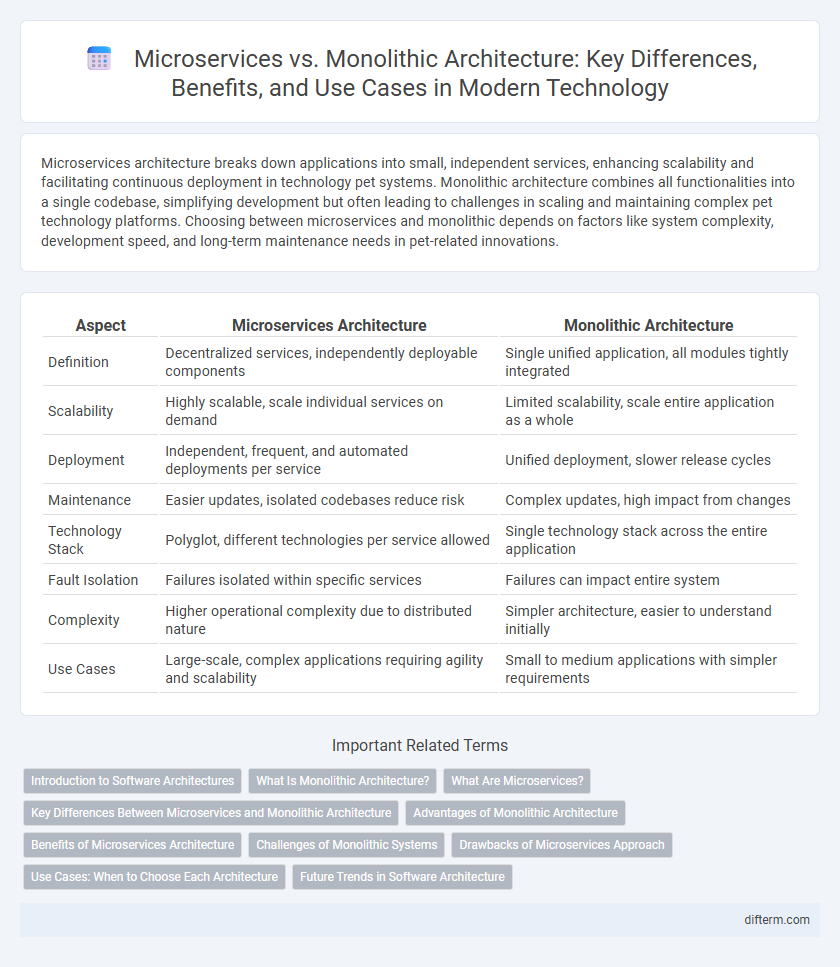Microservices architecture breaks down applications into small, independent services, enhancing scalability and facilitating continuous deployment in technology pet systems. Monolithic architecture combines all functionalities into a single codebase, simplifying development but often leading to challenges in scaling and maintaining complex pet technology platforms. Choosing between microservices and monolithic depends on factors like system complexity, development speed, and long-term maintenance needs in pet-related innovations.
Table of Comparison
| Aspect | Microservices Architecture | Monolithic Architecture |
|---|---|---|
| Definition | Decentralized services, independently deployable components | Single unified application, all modules tightly integrated |
| Scalability | Highly scalable, scale individual services on demand | Limited scalability, scale entire application as a whole |
| Deployment | Independent, frequent, and automated deployments per service | Unified deployment, slower release cycles |
| Maintenance | Easier updates, isolated codebases reduce risk | Complex updates, high impact from changes |
| Technology Stack | Polyglot, different technologies per service allowed | Single technology stack across the entire application |
| Fault Isolation | Failures isolated within specific services | Failures can impact entire system |
| Complexity | Higher operational complexity due to distributed nature | Simpler architecture, easier to understand initially |
| Use Cases | Large-scale, complex applications requiring agility and scalability | Small to medium applications with simpler requirements |
Introduction to Software Architectures
Microservices architecture divides applications into small, independent services that communicate through APIs, enabling scalability and continuous deployment. Monolithic architecture consolidates all components into a single, unified codebase, simplifying development but limiting flexibility and scalability. Understanding these software architectures guides decisions on system design, performance, and maintenance strategies for modern applications.
What Is Monolithic Architecture?
Monolithic architecture is a traditional software design where all components and functionalities are integrated into a single, unified codebase, making deployment and scaling less flexible. This architecture typically results in tightly coupled modules, which can complicate maintenance and hinder the adoption of new technologies or updates. Organizations often face challenges with monolithic systems in managing large codebases and achieving efficient continuous delivery pipelines.
What Are Microservices?
Microservices architecture breaks down applications into small, independent services that communicate through APIs, enabling scalability and flexibility. Each microservice is developed, deployed, and maintained independently, allowing faster updates and resilient system design. This contrasts with monolithic architecture, where a single, unified codebase manages the entire application, often limiting agility.
Key Differences Between Microservices and Monolithic Architecture
Microservices architecture divides applications into loosely coupled, independently deployable services, whereas monolithic architecture consolidates all functionalities into a single, unified codebase. Microservices offer enhanced scalability, fault isolation, and flexibility in technology stack choices, while monolithic systems simplify development and deployment but may suffer from scalability bottlenecks and complex maintenance. Key differences include deployment independence, ease of scalability, fault tolerance, and complexity in management and communication overhead.
Advantages of Monolithic Architecture
Monolithic architecture offers easier deployment and simpler testing processes due to its single unified codebase, reducing overhead. It ensures better performance since all functions run within a single process, minimizing latency associated with network calls. This architecture is ideal for small to medium-sized applications where rapid development and straightforward code management are priorities.
Benefits of Microservices Architecture
Microservices architecture enhances scalability by allowing independent deployment and management of services, leading to improved fault isolation and faster development cycles. It supports technology diversity, enabling teams to use the most suitable tools and languages for each service, which increases flexibility and innovation. Microservices also facilitate continuous integration and deployment (CI/CD), reducing time-to-market and improving overall system resilience.
Challenges of Monolithic Systems
Monolithic systems often face scalability challenges due to tightly coupled components that hinder independent scaling and deployment. Debugging and updating monolithic architectures become complex as a single codebase grows, increasing the risk of system-wide failures. Limited flexibility in adopting new technologies further constrains innovation and slows development cycles.
Drawbacks of Microservices Approach
Microservices architecture often faces challenges like increased complexity in managing multiple services and ensuring seamless communication between them. It can lead to difficulties in maintaining data consistency and increased latency due to network overhead. The need for extensive DevOps practices and advanced monitoring tools further complicates deployment and troubleshooting compared to monolithic systems.
Use Cases: When to Choose Each Architecture
Microservices architecture excels in complex, large-scale applications requiring independent deployability, scalability, and continuous integration, ideal for dynamic environments like e-commerce platforms and cloud-native solutions. Monolithic architecture suits simpler, smaller applications where development speed and straightforward deployment are priorities, such as startups or prototypes with limited scalability needs. Choosing between microservices and monolithic architecture depends on factors like team size, application complexity, deployment frequency, and scalability requirements.
Future Trends in Software Architecture
Microservices architecture is rapidly gaining traction due to its scalability, flexibility, and support for continuous delivery, making it ideal for cloud-native and distributed systems. Monolithic architecture, while simpler to develop initially, faces challenges in adapting to the increasing demand for rapid updates and complex integrations. Emerging trends indicate a hybrid approach combining microservices' modularity with monolithic efficiency through technologies like serverless computing and service mesh frameworks will define future software architecture.
Microservices vs Monolithic architecture Infographic

 difterm.com
difterm.com